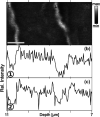Improved Skin Permeability after Topical Treatment with Serine Protease: Probing the Penetration of Rapamycin by Scanning Transmission X-ray Microscopy
- PMID: 34056375
- PMCID: PMC8154144
- DOI: 10.1021/acsomega.1c01058
Improved Skin Permeability after Topical Treatment with Serine Protease: Probing the Penetration of Rapamycin by Scanning Transmission X-ray Microscopy
Abstract
Drug penetration in human skin ex vivo following a modification of skin barrier permeability is systematically investigated by scanning transmission X-ray microscopy. Element-selective excitation is used in the O 1s regime for probing quantitatively the penetration of topically applied rapamycin in different formulations with a spatial resolution reaching <75 nm. The data were analyzed by a comparison of two methods: (i) two-photon energies employing the Beer-Lambert law and (ii) a singular value decomposition approach making use of the full spectral information in each pixel of the X-ray micrographs. The latter approach yields local drug concentrations more reliably and sensitively probed than the former. The present results from both approaches indicate that rapamycin is not observed within the stratum corneum of nontreated skin ex vivo, providing evidence for the observation that this high-molecular-weight drug inefficiently penetrates intact skin. However, rapamycin is observed to penetrate more efficiently the stratum corneum when modifications of the skin barrier are induced by the topical pretreatment with the serine protease trypsin for variable time periods ranging from 2 to 16 h. After the longest exposure time to serine protease, the drug is even found in the viable epidermis. High-resolution micrographs indicate that the lipophilic drug preferably associates with corneocytes, while signals found in the intercellular lipid compartment were less pronounced. This result is discussed in comparison to previous work obtained from low-molecular-weight lipophilic drugs as well as polymer nanocarriers, which were found to penetrate the intact stratum corneum exclusively via the lipid layers between the corneocytes. Also, the role of the tight junction barrier in the stratum granulosum is briefly discussed with respect to modifications of the skin barrier induced by enhanced serine protease activity, a phenomenon of clinical relevance in a range of inflammatory skin disorders.
© 2021 The Authors. Published by American Chemical Society.
Conflict of interest statement
The authors declare no competing financial interest.
Figures




References
LinkOut - more resources
Full Text Sources
Other Literature Sources

